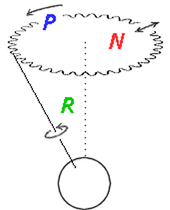Nutation
|
|
Nutation is a slight irregular motion (etymologically a "nodding") in the axis of rotation of a planet, due to the fact that the tidal forces which cause precession of the equinoxes vary over time so that the speed of precession is not constant. It was discovered in 1728 by the English astronomer James Bradley, but was not explained until 20 years later.
In the case of Earth, the principal sources of tidal force are the Sun and Moon, which continually change location relative to each other and thus cause nutation in Earth's axis. The largest component of Earth's nutation has a period of 18.6 years, the same as that of the precession of the Moon's orbital nodes. However, there are other significant periodical terms which must be calculated depending on the desired accuracy of the result. A mathematical description (set of equations) that represents nutation is called a "theory of nutation" (see,e.g. [1] (http://www.iers.org/iers/earth/resolutions/UAI_b3.html)). Generally, the theory is really a theory, in the sense that it applies physical laws and astronomical measurements; however, there may be parameters which are adjusted in a more or less ad hoc way to obtain the best fit to data. As can be seen from the IERS publication just cited, nowadays simple rigid-body mechanics do not give the best theory; one has to account for deformations of the solid Earth.
Values of nutation are usually divided into components parallel and perpendicular to the ecliptic. The component which works along the ecliptic is known as the nutation in longitude. The component perpendicular to the ecliptic is known as the nutation in obliquity. Celestial coordinate systems are based on an "equator" and "equinox," which means a great circle in the sky that is the projection of the Earth's equator outwards, and a line, the Vernal equinox intersecting that circle, which determines the starting point for measurement of right ascension. These items are affected both by precession of the equinoxes and nutation, and thus depend on the theories applied to precession and nutation, and on the date used as a reference date for the coordinate system. In simpler terms, nutation (and precession) values are important in observation from Earth for calculating the apparent positions of astronomical objects.
Because the dynamics of the planets are so well known, nutation can be calculated within seconds of arc over periods of many decades. There is another disturbance of the Earth's rotation called polar motion that can be estimated only a few months ahead, because it is influenced by rapidly and unpredictably varying things such as ocean currents, wind systems, and motions in the Earth's core.de:Nutation (Astronomie) es:Nutación it:Nutazione nl:Nutatie pl:Nutacja

